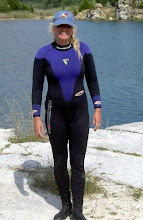
(picture courtesy of earl53 at morguefile.com)
A sure-fire way to cause diver trauma is by shooting to the surface. Thank goodness the divemaster was strong as the student struggled to right himself and keep from floating up to the surface. Neutral buoyancy was a skill to still be learned by the newbie, as was about a jillion other things. But the calm dive master candidate reached over and grabbed the student's BC and dumped the air from the purge valve, all without moving from his spot. Later, Mr. Daisy (the dive master candidate) said, "It's a good thing I have strength in my arms and weight on my side. Otherwise, Student X would have dragged me to the surface with them."
Face it. Most students learn to dive while being over-weighted to keep from shooting to the surface. While in the pool, they learn the proper technique to find neutral buoyancy in their training. First, dump all the air out of your BC while at the surface and hold a normal sized breath. You should hover/float right at eye level and sink when you exhale that breath. But nervousness, full tanks getting lots of heavy breathing, and lack of underwater comfort can later transfer into "fishing bobber" look-alikes. That full tank becomes positively buoyant as it empties!
(picture courtesy of penywise at morguefile.com)
Despite all the weight, students can still become positively buoyant. Sometimes it is because they haven't quite mastered their BC controls yet. This can lead to dangers for them AND for the dive master candidates. And if a DMC isn't "properly weighted," they can have difficulty doing their job.
Being a dive master candidate means being prepared. And in water that means having
1. enough strength to compensate for both of you while attending to a positively buoyant student OR
2. enough weight in the belt to compensate for a positively buoyant student.
So, DMC's have worked hard to perfect the art of neutral buoyancy to make it look easy for students, yet they are many times over-weighted when helping out the very people they most need to be role models for.
Scuba diving tends to be a man's sport. PADI, one of the largest companies educating scuba divers, believes that worldwide, only 28% of divers are female. This can cause issues with both weight and strength. In a question about gender and who is a better diver, Lawrence Martin wrote, "The long answer is that women, on average, have smaller lungs, a lower aerobic capacity, a greater percentage of body fat, and less upper body strength than men, and these differences have some effects on diving." (http://www.lakesidepress.com/pulmonary/books/scuba/women.htm , October 27,2008) It should be noted that he was discussing recreational diving, rather than women in diving education roles.
The fact remains that I weigh a lot less than most of the students, male or female. And while I work at remaining in shape and staying strong, I cannot overpower and muscle my way through. I have to use other tactics, such as overweighting, to be able to help my students and keep them safe. Having had this discussion with various instructors, one said, "You gotta do what you gotta do."








No comments:
Post a Comment